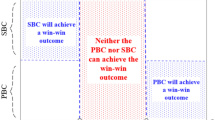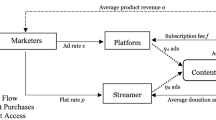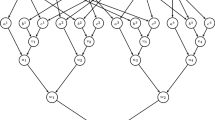Abstract
In this paper, we investigate the optimal subscription strategy for network video platforms and show how it is affected by social influence. The strategy decision is made among paid strategies, free strategies, and trial strategies, and revenue models are presented in two cases: positive social influence and negative social influence. We show that regardless of which strategy a platform adopts, positive social influence always makes a platform better. Results run counter to the conventional wisdom that positive social influence has an adverse effect on subscription demand without a free trial, which is benefited under negative social influence. A platform can always benefit from offering trial clips in the presence of positive social influence. A paid strategy is optimal if a video generates less social influence and advertising becomes more of a nuisance for consumers. A free strategy, otherwise, is dominant. In the presence of negative social influence, however, a free strategy is always the worst choice for a platform. Moreover, we found that positive social influence expands a consumer’s tolerance of advertising when compared to a video with no social influence.






Similar content being viewed by others
References
Trusov, M., Bucklin, R. E., & Pauwels, K. (2009). Effects of Word-of-Mouth versus traditional marketing: Findings from an internet social networking site. Journal of Marketing, 73(5), 90–102.
Zhao, N., & Li, H. (2020). How can social commerce be boosted? The impact of consumer behaviors on the information dissemination mechanism in a social commerce network. Electronic Commerce Research, 20, 833–856.
Manchanda, P., Xie, Y., & Youn, N. (2008). The role of targeted communication and contagion in product adoption. Management Science, 27(6), 961–976.
Tan, D. Q., & Li, Q. (2017). Study on provision model choices, Price and advertising level for operators’ online video content. Management Review, 29(4), 91–97.
Wang, Y., Feng, H., Li, M., & Feng, N. (2020). Optimal release strategy for the competing software vendors based on word-of-mouth effect. International Journal of Electronic Commerce, 24(1), 130–156.
Li, Z. P., & Tang, X. J. (2013). Social influence, opinion dynamics and structure balance: A simulation study based on Hopfield network. Systems Engineering-Theory and Practice, 33(2), 420–429.
Bapna, R., & Umyarov, A. (2015). Do your online friends make you pay? A randomized field experiment on peer influence in online social networks. Management Science, 61(8), 1902–1920.
Hu, M., Milner, J., & Wu, J. H. (2016). Liking and following and the newsvendor: Operations and marketing policies under social influence. Management Science, 62(3), 867–879.
Moretti, E. (2011). Social learning and peer effects in consumption: Evidence from movie sales. Review of Economic Studies, 78(1), 356–393.
Wang, Q., Meng, L., Liu, M., Wang, Q., & Ma, Q. G. (2016). How do social-based cues influence consumers’ online purchase decisions? An event-related potential study. Electronic Commerce Research, 16, 1–26.
Yang, H. C., & Wang, Y. (2015). Social sharing of online videos: Examining American consumers’ video sharing attitudes, intent, and behavior. Psychology and Marketing, 32(9), 907–919.
Balasubramanian, S., Bhattacharya, S., & Krishnan, V. V. (2015). Pricing information goods: A strategic analysis of the Selling and Pay-per-Use Mechanisms. Marketing Science, 34(2), 218–234.
Kind, H. J., Nilssen, T., & Sørgard, L. (2009). Business models for media firms: Does Competition matter for how they raise revenue? Marketing Science, 28(6), 1112–1128.
Kumar, S., & Sethi, S. P. (2009). Dynamic pricing and advertising for web content providers. European Journal of Operational Research, 197(3), 924–944.
Peitz, M., & Valletti, T. M. (2008). Content and advertising in the media: Pay-tv versus free-to-air. International Journal of Industrial Organization, 26(4), 949–965.
Rao, A. (2015). Online content pricing: Purchase and rental markets. Marketing Science, 34(3), 430–451.
IResearch. (2018). The report of China’s business situation in online video. China e-commerce industry report. http://report.iresearch.cn/report/201805/3216.shtml. Accessed 6 Jan 2020.
Halbheer, D., Stahl, F., Koenigsberg, O., & Lehmann, D. R. (2014). Choosing a digital content strategy: How much should be free? International Journal of Research in Marketing, 31(2), 192–206.
Ghosh, B., & Stock, A. (2010). Advertising effectiveness, Digital video recorders, and product market competition. Marketing Science, 29(4), 639–649.
Kannan, P. K., Pope, B. K., & Jain, S. (2009). Pricing digital content product lines: A model and application for the national academies press. Marketing Science, 28(4), 620–636.
Koukova, N. T., Kannan, P., & Kirmani, A. (2012). Multi-format digital products: How design attributes interact with usage situations to determine choice. Journal of Marketing Research, 49(1), 100–114.
Pauwels, K., & Weiss, A. (2008). Moving from free to fee: How online firms market to change their business model successfully. Journal of Marketing, 72(3), 14–31.
Cheng, H. K., & Liu, Y. (2012). Optimal software free trial strategy: The impact of network externalities and consumer uncertainty. Information Systems Research, 23, 488–504.
Nan, G. F., Li, X. T., Zhang, Z., & Li, M. Q. (2018). Optimal pricing for new product entry under free strategy. Information Technology and Management, 19, 1–19.
Wang, H. P., Liu, S. L., & Lin, J. (2017). Competitive analysis of time-locked free trial strategy of duopoly. Operations Research and Management Science, 26(12), 23–30.
Godes, D., Ofek, E., & Sarvary, M. (2009). Content versus advertising: The impact of competition on media firm strategy. Marketing Science, 1, 20–35.
Casadesus-Masanell, R., & Zhu, F. (2010). Strategies to fight Ad-Sponsored rivals. Management Science, 56(9), 1484–1499.
Li, S. L., Luo, Q., Qiu, L., & Bandyopadhyay, S. (2020). Optimal pricing model of digital music: Subscription, ownership or mixed? Production and Operations Management, 29(3), 688–704.
Lambrecht, A., & Misra, K. (2016). Fee or free: When should firms charge for online content? Management Science, 62(4), 446–469.
Nan, G. F., Shi, F. H., Dou, R. L., & Li, M. Q. (2016). Duopoly pricing of software products under free strategy: Limited-feature versus seeding. Computers and Industrial Engineering, 100, 13–23.
Yi, Z. L., Li, F., & Ma, L. J. (2019). The impact of distribution channels on trial-version provision with a positive network effect. Omega, 85, 115–133.
Harré, R. (1986). The dictionary of personality and social psychology. The MIT Press.
Chen, C. C., Shih, S. Y., & Lee, M. (2016). Who should you follow? Combining learning to rank with social influence for informative friend recommendation. Decision Support Systems, 90, 33–45.
Dewan, S., Ho, Y. J., & Ramaprasad, J. (2017). Popularity or proximity: Characterizing the nature of social influence in an online music community. Information Systems Research, 28(1), 117–136.
Hou, R. Q., Kosterb, D. R., & Yua, Y. G. (2018). Service investment for online retailers with social media—Does it pay off? Transportation Research Part E, 118, 606–628.
Sun, S. X., Zheng, X. N., & Sun, L. P. (2020). Multi-period pricing in the presence of competition and social influence. International Journal of Production Economics. https://doi.org/10.1016/j.ijpe.107662
Shen, B., Qian, R. R., & Choi, T. M. (2017). Selling luxury fashion online with social influences considerations: Demand changes and supply chain coordination. International Journal of Production Economics, 185, 89–99.
Lee, Y. J., Hosanagar, K., & Tan, Y. (2015). Do I follow my friends or the crowd? Information cascades in online movie ratings. Management Science, 61(9), 2241–2258.
Roethke, K., Klumpe, J., Adam, M., & Alexander, B. (2020). Social influence tactics in e-commerce onboarding: The role of social proof and reciprocity in affecting user registrations. Decision Support Systems, 113268, 1–12.
Fainmesser, I. P., Lauga, D. O., & Ofek, E. (2020). Ratings, reviews, and the marketing of new products. Management Science. https://doi.org/10.1287/mnsc.2020.3848
Shapiro, C., & Varian, H. R. (1999). Information Rules. Harvard Business School Press.
Li, Q., & Tan, D. Q. (2019). Effect of online video operator free trial on marketing strategy. Chinese Journal of Management Science, 27(1), 143–152.
Venkatesh, V., Morris, M. G., Davis, G. B., & Davis, F. D. (2003). User acceptance of information technology: Toward a unified view. MIS Quarterly, 27(3), 425–478.
Author information
Authors and Affiliations
Corresponding author
Additional information
Publisher's Note
Springer Nature remains neutral with regard to jurisdictional claims in published maps and institutional affiliations.
Appendix
Appendix
1.1 Proof of Proposition 1
The derivatives of revenues under the three strategies with respect to \(\lambda\) in the presence of positive social influence are: \(\frac{{\partial \Pi^{{SF^{ + *} }} }}{\partial \lambda } = \frac{1}{{4\delta (\lambda - 1)^{2} }} > 0\), \(\frac{{\partial \Pi^{{SP^{ + *} }} }}{\partial \lambda } = \frac{1}{{4(\lambda - 1)^{2} }} > 0\), \(\frac{{\partial \Pi^{{SM^{ + *} }} }}{\partial \lambda } = \frac{4\chi (1 - \lambda )}{{(\delta \chi^{2} + 2(\lambda - 1)^{2} )^{2} }} > 0\).
Similarly, the derivatives of revenues under the three strategies with respect to \(\lambda\) in the presence of negative social influence are: \(\frac{{\partial \Pi^{{SF^{ - *} }} }}{\partial \lambda } = - \frac{1}{{4\delta (\lambda + 1)^{2} }} < 0\), \(\frac{{\partial \Pi^{{SP^{ - } *}} }}{\partial \lambda } = - \frac{1}{{4\delta (\lambda + 1)^{2} }} < 0\), \(\frac{{\partial \Pi^{{SM^{ - *} }} }}{\partial \lambda } = - \frac{4\chi (1 + \lambda )}{{(\delta \chi^{2} + 2(\lambda + 1)^{2} )^{2} }} < 0\).
To conclude, we obtain Proposition 1.
1.2 Proof of Proposition 2
1. The derivatives of demand under a free strategy or a paid strategy with respect to \(\lambda\) in the case of positive or negative social influence are \(\frac{{\partial D^{{SF^{ + *} }} }}{\partial \lambda } = \frac{1}{{2(\lambda - 1)^{2} }} > 0\), \(\frac{{\partial D^{{SP^{ + *} }} }}{\partial \lambda } = \frac{1}{{2(\lambda - 1)^{2} }} > 0\), \(\frac{{\partial D^{{SF^{ - *} }} }}{\partial \lambda } = - \frac{1}{{2(\lambda + 1)^{2} }} < 0\) and \(\frac{{\partial D^{{SP^{ - *} }} }}{\partial \lambda } = - \frac{1}{{2(\lambda + 1)^{2} }} < 0\).
2. The derivatives of the demand under a trial strategy with respect to \(\lambda\) in the case of negative or positive social influence are:
For \(\frac{{\partial D_{3}^{{^{{SM^{{ + *}} }} }} }}{\partial \lambda }\), we identify three cases with the constraint \(\delta \in \left( {\frac{1 - \lambda }{\chi },\frac{2(1 - \lambda )}{\chi }} \right)\): (i). If \(0 < \lambda < 1 - \chi\) we have \(\frac{{\partial D_{3}^{{^{{SM^{{ + *}} }} }} }}{\partial \lambda } > 0\). (ii) If \(1 - \chi < \lambda < 1 - \frac{\chi }{2}\), we obtain the threshold \(\delta_{1} = \frac{{2(\lambda - 1)^{2} }}{{\chi^{2} }}\). When \(\delta < \delta_{1}\), we have \(\frac{{\partial D_{3}^{{SM^{ + *} }} }}{\partial \lambda } > 0\). When \(\delta > \delta_{1}\), we have \(\frac{{\partial D_{3}^{{SM^{ + *} }} }}{\partial \lambda } < 0\). (iii) If \(1 - \frac{\chi }{2} < \lambda < 1\), we have \(\frac{{\partial D_{3}^{{SM^{ + *} }} }}{\partial \lambda } < 0\). To conclude, we obtain Proposition 2.
1.3 Proof of Proposition 3
The derivatives of a subscription fee under a trial strategy with respect to \(\lambda\) in the presence of social influences are \(\frac{{\partial P^{{SM^{ + *} }} }}{\partial \lambda } = \frac{{2\chi (2(\lambda - 1)^{2} - \delta \chi^{2} )}}{{(\delta \chi^{2} + 2(\lambda - 1)^{2} )^{2} }}\) and \(\frac{{\partial P^{{SM^{ - *} }} }}{\partial \lambda } = \frac{{2\chi (\delta \chi^{2} - 2(\lambda + 1)^{2} )}}{{(\delta \chi^{2} + 2(\lambda - 1)^{2} )^{2} }} < 0\). For \(\frac{{\partial P^{{SM^{ + *} }} }}{\partial \lambda }\), we identify three cases with the constraint \(\delta \in \left( {\frac{1 - \lambda }{\chi },\frac{2(1 - \lambda )}{\chi }} \right)\): (i) If \(0 < \lambda < 1 - \chi\) we have \(\frac{{\partial P^{{SM^{ + *} }} }}{\partial \lambda } > 0\). (ii) If \(1 - \chi < \lambda < 1 - \frac{\chi }{2}\), we obtain the threshold \(\delta_{1} = \frac{{2(\lambda - 1)^{2} }}{{\chi^{2} }}\). When \(\delta < \delta_{1}\), we have \(\frac{{\partial P^{{SM^{ + *} }} }}{\partial \lambda } > 0\). When \(\delta > \delta_{1}\), we have \(\frac{{\partial P^{{SM^{ + *} }} }}{\partial \lambda } < 0\). (iii) If \(1 - \frac{\chi }{2} < \lambda < 1\) we have \(\frac{{\partial P^{{SM^{ + *} }} }}{\partial \lambda } < 0\). From the optimal outcomes in Sect. 3.1 and Sect. 3.2, we obtain \(P^{NP*} = P^{{SP^{{ + *}} }} = P^{{SP^{ - *} }}\).
To conclude, we obtain Proposition 3.
1.4 Proof of Proposition 4
The derivatives of the quantity of advertising under a trial strategy with respect to \(\lambda\) in the case where there is positive or negative social influence are \(\frac{{\partial a^{{SM^{ + *} }} }}{\partial \lambda } = \frac{{4\chi^{2} (1 - \lambda )}}{{(\delta \chi^{2} + 2(\lambda - 1)^{2} )^{2} }} > 0\) and \(\frac{{\partial a^{{SM^{ - *} }} }}{\partial \lambda } = - \frac{{4\chi^{2} (1 + \lambda )}}{{(\delta \chi^{2} + 2(\lambda + 1)^{2} )^{2} }} < 0\). From the optimal outcomes in Sects. 3.1 and 3.2, we can obtain \(a^{NF*} = a^{{SF^{ + *} }} = a^{{SF^{ - *} }}\).
1.5 Proof of Corollary 1
Comparing the revenue under a free strategy with a paid strategy in the presence of social influence, we have:\(\Pi^{{SF^{ + *} }} - \Pi^{{SP^{ + *} }} = \frac{\delta - 1}{{4\delta \left( {\lambda - 1} \right)}}\) 和 \(\Pi^{{SF^{ - *} }} - \Pi^{{SP^{ - *} }} = \frac{1 - \delta }{{4\delta \left( {\lambda + 1} \right)}}\). Based on the constraint of \(\delta \in \left( {\frac{1}{\chi },\frac{2}{\chi }} \right)\) in the presence of no social influence and \(\delta \in \left( {\frac{1 + \lambda }{\chi },\frac{2(1 + \lambda )}{\chi }} \right)\) in the presence of negative social influence, we can derive \(\delta > 1\). Futhermore, the degree of consumers’ attitudes towards advertising can be derived as \(\delta < 1\) and \(\delta > 1\) under the condition of \(\delta \in \left( {\frac{1 - \lambda }{\chi },\frac{2(1 - \lambda )}{\chi }} \right)\) in the presence of positive social influence. To conclude, we obtain Corollary 1.
1.6 Proof of Corollary 2
Comparing the revenue under a free strategy with a trial strategy in the presence of social influence, we have \(\Pi^{{SF^{ + *} }} - \Pi^{{SM^{ + *} }} = \frac{{H\left( \delta \right)_{1} }}{{4\delta \left( {1 - \lambda } \right)\left( {\delta \chi^{2} { + }2\left( {\lambda - 1} \right)^{2} } \right)}}\) and \(\Pi^{{SF^{ - *} }} - \Pi^{{SM^{ - *} }} = \frac{{H\left( \delta \right)_{2} }}{{4\delta \left( {1 + \lambda } \right)\left( {\delta \chi^{2} + 2\left( {\lambda + 1} \right)^{2} } \right)}}\). i. There are four cases to consider in function \(H\left( \delta \right)_{1} = \left( {4\lambda \chi + \chi^{2} - 4\chi } \right)\delta + 2\left( {\lambda - 1} \right)^{2}\) with the constraint \(\delta \in \left( {\frac{1 - \lambda }{\chi },\frac{2(1 - \lambda )}{\chi }} \right)\):
Case 1: For \(0 < \lambda < 1 - \frac{\chi }{2}\), \(H\left( \delta \right)_{1}\), a decreasing function, we have \(H\left( \delta \right)_{1} < 0\).
Case 2: For \(1 - \frac{\chi }{2} < \lambda < 1 - \frac{\chi }{3}\), we obtain the threshold \(\delta_{2} = \frac{{2\left( {\lambda - 1} \right)^{2} }}{{\chi \left( {4\lambda + \chi - 4} \right)}}\). We have \(H\left( \delta \right)_{1} > 0\) when \(\delta < \delta_{2}\), and we have \(H\left( \delta \right)_{1} < 0\) when \(\delta > \delta_{2}\).
Case 3: For \(1 - \frac{\chi }{3} < \lambda < 1 - \frac{\chi }{4}\), we can derive \(\delta_{2} > \frac{{2\left( {1 - \lambda } \right)}}{\chi }\) and \(H\left( \delta \right)_{1}\) is a decreasing function, thus \(H\left( \delta \right)_{1} > 0\).
Case 4: For \(1 - \frac{\chi }{4} < \lambda < 1\), \(H\left( \delta \right)_{1}\) is an increasing function and we have \(H\left( \delta \right)_{1} > 0\).
ii. We know \(H\left( \delta \right)_{2} = \left( {\chi^{2} - 4\chi - 4\lambda \chi } \right)\delta + 2\left( {\lambda + 1} \right)^{2}\) is a decreasing function and \(H\left( \delta \right)_{2} < 0\) in the constraint of \(\delta \in \left( {\frac{1 + \lambda }{\chi },\frac{2(1 + \lambda )}{\chi }} \right)\), and, thus, we have \(\Pi^{{SF^{ - *} }} < \Pi^{{SM^{ - *} }}\). To conclude, we obtain Corollary 2.
1.7 Proof of Corollary 3
i. Comparing the revenue under a paid strategy with a trial strategy in the presence of positive social influence, we have \(\Pi^{{SP^{ + *} }} - \Pi^{{SM^{ + *} }} = \frac{{H(\delta )_{3} }}{{4\delta \left( {1 - \lambda } \right)(\delta \chi^{2} { + }2\left( {\lambda - 1} \right)^{2} )}}\), where \(H\left( \delta \right)_{3} = \delta \chi^{2} + 2\left( {\lambda - 1} \right)^{2} + 4\chi \left( {\lambda { + }1} \right)\).
\(H\left( \delta \right)_{3}\) is an increasing function. We now identify three cases in the constraint of \(\delta \in \left( {\frac{1 - \lambda }{\chi },\frac{2(1 - \lambda )}{\chi }} \right)\):
Case 1: \(0 < \lambda < 1 - \frac{3\chi }{2}\), we can easily derive \(H\left( \delta \right)_{3} > 0\), and thus we obtain \(\Pi^{{SP^{ + *} }} > \Pi^{{SM^{ + *} }}\).
Case 2: \(1 - \frac{3\chi }{2} < \lambda < 1 - \chi\), we obtain the threshold \(\delta_{3} = \frac{{2\left( {\lambda + 2\chi - 1} \right)\left( {1 - \lambda } \right)}}{{\chi^{2} }}\), if \(\delta < \delta_{3}\),\(H\left( \delta \right)_{3} < 0\). If \(\delta > \delta_{3}\),\(H\left( \delta \right)_{3} > 0\).
Case 3: \(1 - \chi < \lambda < 1\), we can derive \(H\left( \delta \right)_{3} < 0\), and, thus, we obtain \(\Pi^{{SP^{ + *} }} < \Pi^{{SM^{ + *} }}\).
ii. Comparing the revenue under a paid strategy with a trial strategy in the presence of negative social influence, we have \(\Pi^{{SP^{ - *} }} - \Pi^{{SM^{ - *} }} = \frac{{H(\delta )_{4} }}{{4\delta \left( {1 + \lambda } \right)(\delta \chi^{2} + 2\left( {\lambda + 1} \right)^{2} )}}\), where \(H\left( \delta \right)_{4} = \delta \chi^{2} + 2\left( {\lambda + 1} \right)\left( {\lambda + 1 - 2\chi } \right)\).
\(H\left( \delta \right)_{4}\) is a monotonic increasing function. We identify two cases with the constraint \(\delta \in \left( {\frac{1 + \lambda }{\chi },\frac{2(1 + \lambda )}{\chi }} \right)\):
Case 1: \(0 < \lambda < \frac{3\chi }{2} - 1\), we obtain the threshold \(\delta_{4} = \frac{{2\left( {1 - \lambda + 2\chi } \right)\left( {1 + \lambda } \right)}}{{\chi^{2} }}\). If \(\delta < \delta_{4}\), we can derive \(H\left( \delta \right)_{4} < 0\). If \(\delta > \delta_{4}\), we can derive \(H\left( \delta \right)_{4} > 0\).
Case 2: \(\frac{3\chi }{2} - 1 < \lambda < 1\), we can derive \(H\left( \delta \right)_{4} > 0\), and, thus, we obtain \(\Pi^{{SP^{ - *} }} > \Pi^{{SM^{ - *} }}\).
To conclude, we obtain Corollary 3.
Rights and permissions
About this article
Cite this article
Wang, W., Guo, Q. Subscription strategy choices of network video platforms in the presence of social influence. Electron Commer Res 23, 577–604 (2023). https://doi.org/10.1007/s10660-021-09504-w
Accepted:
Published:
Issue Date:
DOI: https://doi.org/10.1007/s10660-021-09504-w




